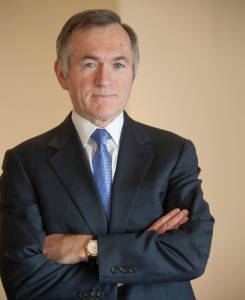Finance Magnates spoke with David Puth, CEO of CLS Group for his comprehensive outlook of the foreign exchange (FX) industry, the group's role in the market, as well as upcoming challenges for the settlement utility in H2 2015 and beyond.
How do you see CLS's role in the foreign exchange market? Could you explain in a nutshell where CLS comes into play in an FX transaction?
Settlement risk is the most significant risk in foreign exchange (FX), and mitigating it is essential to the smooth and efficient running of the market.
Settlement risk is the risk that one party to a trade delivers the currency it sold, but does not receive the currency it bought, resulting in a loss of principal. CLS prevents this by simultaneously settling the Payments on both sides of the trade using our unique payment-versus-payment settlement service.
All other financial markets are dependent on the effective functioning of the FX market

David Puth, CEO, CLS
CLS was created in 2002 to eliminate settlement risk, making it a crucial element of the global financial infrastructure. Essentially, CLS acts as an intermediary between two counterparties in an FX trade. Once the trade has been executed, the counterparties need to exchange the value of the trade in whatever currency they traded. This is done via CLS, which settles the payments simultaneously, preventing any loss of principal.
Today, CLS has more than 60 settlement members, comprising the world’s largest financial institutions, and over 18,000 third-party clients based in 88 jurisdictions around the world. Banks, asset managers, pension funds, corporations and insurers, to name a few, are all beneficiaries of our service.
Offering settlement services, CLS is at the core of the FX market. How would you characterize foreign exchange from other markets?
The FX market operates 24 hours a day and is one of the largest and most liquid markets in the world. Exchanging currency is essential for a wide range of financial and non-financial institutions, including central banks looking to stabilize their country’s currency, banks trading on behalf of customers or international corporations seeking to reduce their exposure to currency fluctuations.
Following the SNB announcement, CLS settled a record number of 2.26 million transactions worth USD9.2 trillion in one day
Due to its global nature and round-the-clock access, all other financial markets, from equities to bonds, are dependent on the effective functioning of the FX market. Therefore, the stability of this market is integral to the entire financial industry.
CLS’s role in maintaining this stability and mitigating risk cannot be over-emphasized. Such is its importance to the stability of the global financial system, CLS is one of only eight market infrastructures designated as a systematically important financial market utility by the US Financial Stability Oversight Council, part of the US Department of the Treasury.
What strategic plans do CLS have in the pipeline and what are the biggest challenges for CLS for 2015?
Our main focus is to make sure that the FX market can depend on CLS for a seamless delivery of its settlement service under all market conditions. To ensure this happens, we are continuing to invest in new technology and to develop our risk management and operational systems to ensure we meet the future needs of the market.
As activity and participation in CLS continues to grow, it is clear that institutions recognize the additional benefits that CLS provides, including; enhanced operational efficiencies, improved Liquidity management and increased trading capacity with existing and additional counterparties.
We are seeing an increased demand for our services as the FX market continues to evolve, and efforts to increase our membership base and bring in new participants who meet the eligibility criteria will continue throughout 2015.
We are working closely with central banks to introduce new currencies for settlement and remain in active and respectful dialogue with stakeholders in several jurisdictions.
We are also exploring new partnerships and services that make the most of our core capabilities and benefit our shareholders and members. For example, we are collaborating with TriOptima to deliver a a compression service for FX forwards later this year. The new service will enable participants to reduce the number of trades effectively, limit their gross notional exposures and therefore reduce counterparty credit risk and leverage ratios, while ensuring compliance with EMIR, Basel III and Dodd-Frank.
Has the recent volatility in the CHF impacted the business in any material way?
The SNB’s decision to remove the CHF currency ceiling against the euro in January resulted in unprecedented levels of trading activity across the FX market and this was a factor behind the 16% rise in average daily volumes submitted to CLS during January.
Additionally, CLS settled a record number of transactions following the SNB announcement, settling 2.26 million transactions with a value totaling USD9.2 trillion in one day.
How fragmented is the FX market currently? Is this a good thing or a bad thing overall?
The FX market is inherently global and diverse in nature, and fragmentation is a natural evolution. The increased number of trading platforms available provides more competition and greater choice for market participants, allowing them to find the provider that best suits their individual needs and trading strategies.
CLS remains in active and respectful dialogue with stakeholders in several jurisdictions [about adding currencies]
However, we must ensure that the market remains stable and continues to run smoothly. A common, global standard is needed to make sure all participants operate on the same level, regardless of their geographical location or jurisdiction.
CLS’s operational standards function on an international scale and our continuous investment in technology ensures that we continue to provide risk mitigation across borders for all CLS participants.
In the wake of recent FX scandals, do you envision a move towards a more centralized and universal FX market structure?
The FX market has undergone somewhat of an evolution over the last few years; electronic trading has steadily increased and key emerging market currencies have become more predominant. The OTC environment of the FX market has been instrumental in this, allowing for sustained growth and flourishing competition, resulting in lower transaction costs and greater technological innovation. While there has been some talk about changing the structure of the FX market, the overall market infrastructure remains global and broadly functions very well.
Regardless of any changes to the manner in which FX is traded, settlement risk will remain the biggest risk in foreign exchange and this is what we continue to mitigate. Over the past 13 years, CLS has operated seamlessly during times of market stress. Following the SNB’s decision to remove the CHF currency floor in January, CLS simply worked and did what it was designed for – mitigating FX settlement risk during periods of exceptionally high volatility and facilitating liquidity flow.
CLS has become a rather dominant player in FX settlements, what was the firm’s route to this point?
The genesis of the drive to eliminate settlement risk goes back to 1974, when the German bank Bankhaus Herstatt was closed down in the midst of several major foreign currency transactions.
Its counterparties had already delivered their obligations, but Bankhaus Herstatt was unable to meet its commitments, so its counterparties never received the currencies they were promised. This started a chain reaction, or contagion.
Over the next three days, the amount of gross funds transferred in the multilateral net settlement system in New York declined by an estimated 60 percent, amid concerns over exchange settlement risk.
This type of settlement risk — the possibility that a counterparty will fail to meet its side of a foreign exchange obligation — soon became known as “Herstatt risk”. It remains the biggest risk to the largest and most liquid market in the world.
In the period after the Bankhaus Herstatt failure, work was undertaken to reduce the risk that a foreign exchange counterparty would default before honoring its obligations.
This, ultimately, led to the creation of CLS, which provides a payment versus payment (PVP) process that enables member banks of CLS to trade foreign currencies without assuming the settlement risk associated with the process, whereby a counterparty could fail before delivering their leg of the transaction.
CLS launched in 2002 with 39 Members and seven currencies. Today, we have over 18,000 institutions that settle trades in 17 global currencies – exchanging a value of USD5.1 trillion a day on average. The formation of CLS to mitigate settlement risk in the foreign exchange market was the result of a great collaboration between central banks, regulators and the private banking community.
The system delivers this mitigation through the provision of its unique payment-versus-payment settlement service, which has direct links to the RTGSs of the currencies it settles, in addition to streamlining and standardizing FX operations, reducing costs.
FX settlement includes potentially large cash-funding values. These values are materially reduced through the multilateral netting of the obligations between CLS member banks to deliver best-in-class liquidity management. As regulatory requirements for larger liquidity buffers increase, the benefits from multilateral netting at an industry level are increasingly important.
Currently there are 17 currencies eligible for settlement at CLS. Do you plan to increase that number?
Enabling a currency through CLS is the optimal route to maintain an orderly FX market, giving counterparties the confidence that they have the appropriate protection from settlement risk in the world’s largest and most liquid market.
CLS remains in active and respectful dialogue with stakeholders in several jurisdictions. As a systemically important financial system, our role is to facilitate the process for the orderly introduction of each currency as appropriate, and as we have done with the 17 currencies already settled through the system, working with entities including central banks, regulators and our members as appropriate.
Ultimately, the rate and pace of onboarding a currency to the CLS system is driven by individual central banks in their jurisdictions. They are responsible for their currency and it is absolutely right that any proposed changes are managed with care, diligence and full cooperation and agreement with these institutions.
In terms of current activity, and with the above in mind, we moved into the implementation phase of onboarding the Hungarian forint in Q4 2014. The go-live is targeted for November 2015, subject to the satisfaction of CLS’s eligibility criteria and internal governance requirements and securing the necessary regulatory approvals.

















